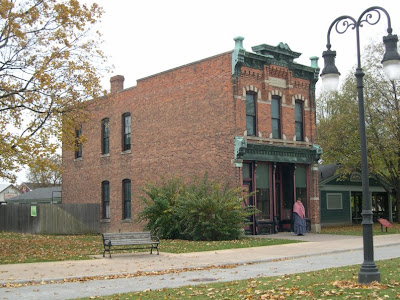Original Buildings in the Village for the October 1929 Grand Opening But Are There No Longer
 At this point, the buildings I have written about so far in each chapter of this blog, barring a few exceptions, are what Henry Ford had erected in the Village at the time of the grand opening that took place on October 21, 1929. I say "barring a few exceptions" because there were a number of other structures that were originally placed in the Village for the 1929 Jubilee that have since been removed. The above map - a copy of the original handed out on that very first rain-filled evening - will show the reader Henry Ford's original plan for Greenfield Village.
At this point, the buildings I have written about so far in each chapter of this blog, barring a few exceptions, are what Henry Ford had erected in the Village at the time of the grand opening that took place on October 21, 1929. I say "barring a few exceptions" because there were a number of other structures that were originally placed in the Village for the 1929 Jubilee that have since been removed. The above map - a copy of the original handed out on that very first rain-filled evening - will show the reader Henry Ford's original plan for Greenfield Village.Some of the buildings listed below I have information on while others are seemingly lost to history (at least until I can make it back to the Benson Ford Research Center).
I also plan to add more photos as I am able to acquire them.
Please check the above map and compare with the structures below as well as what I have previously written about.
And stay tuned to see how Greenfield Village grew over the years.













Comments
Like you I have been visiting Greenfield Village for many years. I was aware of some buildings that have been removed in recent years. I decided to do a little more research to identify other former buildings that are gone, which is how I came across your great blog.
I am leaving this note to comment on The Substation and The Locomotive Shed, which as you pointed out, showed up on the early map of the village. The substation is actually another name for the Edison Illuminating Company’s Station A, which still exists in the village. If you look at the old map, this is the same location as the present building.
The locomotive shed on the old map is located across the street from the Menlo Park Complex. When the village originally opened, Thomas Edison’s electric train locomotive was displayed and demonstrated at this location in the shed. The train and shed were later removed. I’m not sure of the exact date, but I think it was in the 1930s.
And thank you for the kind words. Please feel free to pass along any other info and I will make sure to give you credit.